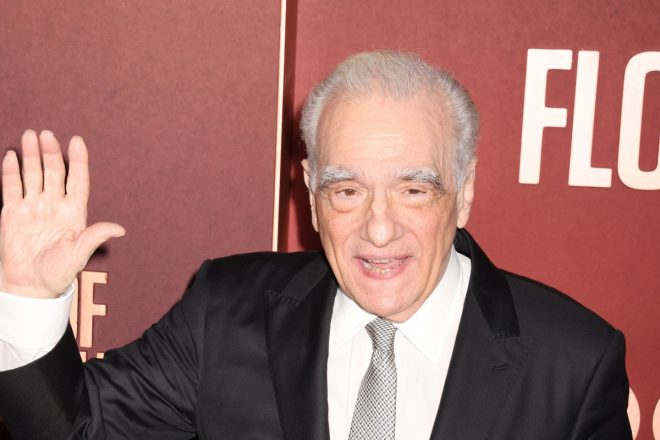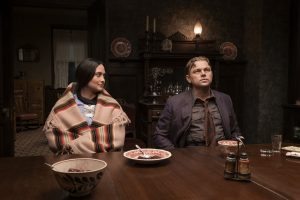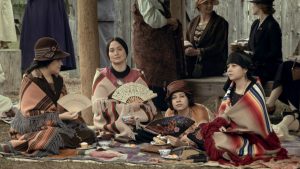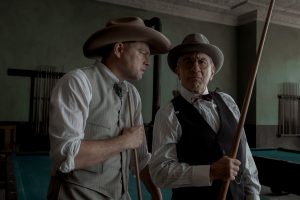By: Izumi Hasegawa November 28, 2023

Legendary director Martin Scorsese is 81 years old, but his passion for filmmaking hasn’t faded a bit! He spoke about the challenges of his latest film and the Native American present day experience, as well his discovery of Lily Gladstone, and working with longtime collaborators Leonardo DiCaprio and Robert De Niro.

Q: How you wanted to tell this story both historically accurate, but emotionally resident?
This was a constant, the historically accurate. And I should say use the word truthful. You know, you can have a ritual and you shoot a ritual the way it should be. But it may have been slightly different at the time and we had a lot of support from the Osage. The Osage authority, the experts who were giving us the indication about how to go about these things. Johnny Williams and number of other people. So, with them, we tested the accuracy of the rituals, the baby namings, the wedding, and everything that happened at the funerals. All of this sort of thing. In some cases, there was wiggle room because quite honestly I think the last two generations of Osage forgot about or was taken out of their experience because they had to become like white European. They had to become, you know Christians, Catholics, whatever. And so they forgot about all that. In fact, there’s a new resurgence of learning of the language and we had language teachers there and Lily Gladstone learned the language and so did Leo, and so did De Niro, who really fell in love with it. I wanted to do more scenes in Osage but I suggested that maybe it’s too much for him, but he just liked the sound of it and so they were all learning again to put their culture back together through this movie. And we were going with them so what actually if this person puts the blanket on this way and the baby naming is that right? Well, one person would say maybe yes, and another would say maybe no, one would say you have a little room here to play with it and have some creative license, so that’s the way we did it throughout every scene that way and that was done a lot of pre-production and during the shoot, so we had that as a basis. And there are ways they were never insistent, but there were ways they got to me certain information where it was Marianne Bower, for example, was one of our producers and she’s like my archivist and she was able to help keep it all together between myself and the Osage.

Q: Can you talk about the first scene that you shot with Lily Gladstone?
Ellen Lewis (casting director) showed her to me in Certain Women, Kelly Reichardt’s film and I thought she was terrific, and then COVID hit and we weren’t able to meet, so after COVID, after the pandemic was calming down, we met on Zoom and I was very impressed by her presence, the intelligence, and the emotion that’s there in her face, but you see it, you feel it, but it’s very, you know, that it’s all working, something working behind the eyes you could see it happening. Also, her activism which wasn’t overtaking the art. In other words, the art was in the activism in a sense so the art takes over and in a way which we think them would be more resonant later on after you see the movie you may be thinking about it more rather than a person preaching at you and I think the first big scene we did was one of my favorite scenes where she has dinner with Ernest alone and she’s questioning him a little bit of an interrogation. What are you doing here? Are you afraid of him? What’s your religion? All this sort of thing. And then you begin to see there, the connection between the two. And when she says, “Ha ha, Coyote wants money.” And surprisingly he said, “That’s right, I love money.” So she knows, this is the other thing, she knows what she’s getting into. And even her sisters later, which is also a scene that we put in with the Osage, with the Native American actors, they said, “What if we’re talking about the guys while they’re playing that game and we’re talking about my husband and talking about that guy with the blue eyes likes you. And you know, well, I don’t think he just wants money. Well, it doesn’t matter. He’s nice. He wants to settle down. Why don’t we just show that that’s how it could happen?” So that’s the way the script was ultimately created by these moments. So Lily, there was that scene and of course the scene where he’s driving her in the taxi and it’s only one shot. And he says something about, you know, “I want to see who’s going to be in this horse race.” And she answers in Osage. And she says something in Osage. He goes, “What’d you say?” And she says in Osage again. And he says, “Well, I don’t know what that was, but it must have been Indian for handsome devil.” And that’s an improv. And you see her laugh for real. So that moment you have the actual relationship. It’s actually between the two actors. You know, so these were the two moments we felt very comfortable with her. And also we had a feeling that we needed her. We needed her to help us tell her, tell the story of the women there. We would always check with her and work with her on the script. There were scenes that were added, scenes rewritten constantly.

Q: You formed a 20-year partnership with Leonardo DiCaprio and a 50-year partnership with Robert De Niro. Why have you returned to them both so often over the years and what has stood out to you most about their work on Killers of the Flower moon?
Well, in the case of Robert De Niro, we were teenagers together and he’s the only one who really knows where I come from, the people I knew. That sort of thing. Some of them still alive. He knows them. I know his friends, his old friends and we had a real testing ground in the 70s where we tried everything and we found that, you know, we trusted each other. It’s all about trust and love. That’s what it is. And that’s a big deal because very often if an actor has a lot of power and he had a lot of power at that time. An actor could take over your picture. Studio gets angry with you. The actor comes in and takes it over. With him, I never felt that. There was a freedom. There was experimenting and also not afraid of anything. I wasn’t afraid to do something. I just did it and years later, he told me he worked with this kid Leonardo DiCaprio and little boy and in This Boy’s Life and he said you should work with this kid sometime, but it was just casual. But with him a line something like that a recommendation at that time. I think in the early 90s. It’s not casual. He says it casually, but he rarely said that, you know, really tell me he really gave recommendations. And so years go by and I’m presented with Leo with Gangs of New York and we worked together in Gangs. He made Gangs possible, actually. He loved other pictures I’ve made. And he wanted to explore the same territory and so we developed more of a relationship when we did The Aviator and there was a kind of towards the end of it, there was a kind of something happening a maturity with him, not quite sure, but we really clicked in certain scenes and that led to The Departed and then that became much closer. You know, that was a project where Bill Monahan (William Monahan, screenwriter), me, other people were writing all the time and recreating that character that he played. And so during that time, he really found out that even though it was 30 years difference, he has similar sensibilities. He likes pretty much, you know, he’ll come to me and he’ll say, “listen to this record.” It’s Louis Jordan and Ella Fitzgerald. I grew up with it. He’s not bringing me anything new, but he likes it. That’s interesting. Why is he bringing me? He’ll call me and say, you know, “I had a cold and I was looking at Criterion films and, you know, I wanted to catch up on some of these classics. And I saw this incredible movie. It’s incredible. It’s a Japanese picture. It’s called Tokyo Story. Did you ever see it?” I said, this was last year. I said, “Yeah, I mean, it took me a few years to catch up. I couldn’t even understand the Ozu style, seeing it was the first time in the early 70s because we’re used to Orson Welles cameras, you know.” And this guy got it from watching it on a big screen and TV. And that’s very interesting to me to be open that way to older parts of our culture, newer parts of our culture. Of course, the curiosity that he has about other people and other cultures. And there’s a trust. There’s a trust. And even if we can’t get it right away, we know we’ll come up with something, you know, maybe other people have relationships where they come up with a faster. Well, we don’t, we just work it through. For example, the scene between Leo (DiCaprio) and Bob (De Niro) in the jail at the end, that scene ultimately was finally written, I think a few days before we shot it. Working with the two of them and working with Marianne (Marianne Bower, Executive Producer) and everybody because we had said so much and they’ve gone so many different ways, but what does the picture really need? How much more is there for them to say to each other after all that’s happened, you know. And so we went that way. It’s really, you know, it’s trust, particularly doing The Wolf of Wall Street, by the way. He came up with wonderful stuff that was outrageous. And so I pushed him, he pushed me, then I pushed him more than he pushed me, and we went on suddenly. Everything was wild, you know? It’s really quite something. And he had a good energy, too, on the set. That was also important, very important, because in the mornings, I’m not really good, and I get on set, and then I’d see him, or Jonah Hill, or him and Margot Robbie, or him and Lily, and suddenly they’re all like, “hey, that’s okay, let’s work.”
Killers of the Flower Moon is now playing in theaters.
Edited by Tiffany Le / Hollywood News Wire Inc.
